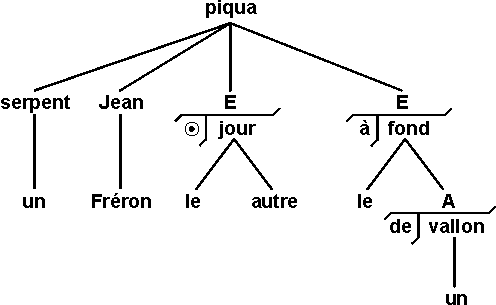Table of Contents
Semantic Network
Introduction
(http://www.jfsowa.com/pubs/semnet.htm)
A semantic network is a graphic notation for representing knowledge in patterns of interconnected nodes and arcs. – Sowa, J. F., Encyclopedia of cognitive science, v.4, 2005, p. 1082
A semantic network is often used as a form of knowledge representation. It is a directed graph consisting of vertices which represent concepts and edges which represent semantic relations between the concepts. – Wikipedia, 2006
Defination: 語義網路(semantic network)指一種具體呈現知識的圖形標示系統(graphic notation),這種圖示系統通常透過節點與連結線等符號繪製成一種網路式的圖樣,以表現概念間的語義關係,進而呈現某種知識的內涵或架構。
語義網路的概念最早在哲學、心理學與語言學中都有涉及,而在當代的計算機研究領域中,被用來發展出人工智慧與自動翻譯技術。在計算機科學中,語義網路被視為一種宣告性的圖示表徵,用以呈現知識或完成自動推論系統。
six kinds of semantic network:
Sowa 在其為人工智慧與認知科學的語義網路百科辭目中,將語義網路區分為六類:
- Definitional networks: 定義式網路: 強調概念間的「主從類別」或是「是…」的關係。其結果稱為概化(generalization)或包含(subsumption)架構,在主類別與子類別間存在繼承屬性的規則。因為此種網路是一種定義式的網路,因此通常都假定必須為真。
- Assertional networks: 宣稱式網路: 以宣稱(assert)某命題(proposition)。與定義式網路不同的是,除非明確地被某情態操作所指明,否則主張式網路中的資訊只是偶然地(contingently)為真。某些主張式網路被視為是自然語言語義的基本概念結構。
- Implicational networks: 蘊涵(暗示)式網路: 以蘊涵(暗示)為節點連結的主要關係。可以用來呈現信念、因果關係、或推論的圖樣。
- Executable networks: 實行式網路: 包含某些機制,如maker passing 或 attached procedures, which can perform inferences, pass messages, or search for patterns and associations.
- Learning networks: 學習式網路: build or extend their representations by acquiring knowledge from examples. Te new knowledge may change the old network by adding and deleting nodes and arcs or by modifying numerical values, callled weihts, associated with the nodes and arcs.
- Hybrid networks: 混合式網路: combine two or more of the previous techniques, either in a single network or in separate, but closely interacting, networks.
某些語義網路是依據人類認知機制的假設設計的,某些主要是為了電腦計算機運作效率的目的。有時,計算機科學的推論需求與心理學證據達到相同的結論。
Definational networks 定義式網路
- monotonic logics 單一邏輯
- FOL (first-order logic): 一階邏輯/初階邏輯/述語邏輯
- non-montonic reasoning 非單一邏輯: 允許增加資訊或減少繼承的資訊
- Nixon diamond
貴格教徒通常是和平主義者;共和黨人通常不是和平主義者;Nixon 既是貴格教徒又是共和黨人。此時要推論Nixon是否是和平主義者,需要 non-nontonic reasoning。

Assertional networks 宣稱式網路
- Charles Sanders Peirce (1880, 1885) -
- modern algebraic notation for predicate calculus 述語計算的代數表記系統
- relational graph
- existential graph (1897)
- Hans Kamp (Kamp and Reyle, 1993) - discourse represtation structure (DRS)
- Roger Schank (1982) - larger structure: scripts (Schank & Abelson 1977), memory organization packets (MOPs), and thematic organization packets (TOPs) (Schank 1982).
- Roger Schank (1994) - case-based reasoning has been used to search for commonly occurring patterns among the lower-level conceptual dependencies (Schank et al. 1994).
- MIND system (1971) - the first propositional semantic networks be implemented in AI developed by Stuart Shapiro.
differencte between those propositional semantic networks:
- Peirce, Sowa, and Kamp used strictily nested propositional enclosures with variables or lines to show coreferences between different enclosures.
- Frege and Shapiro attached the relations to the propositional nodes (or lines in Frege's notation).
- Gary Hendrix (1979)'s partitions enclose the relational content, but with the option of overlapping enclosures if they have common components.
Implicational Networks 蘊涵式網路
蘊涵式網路是命題語義網路(propositional semantic network)的一種特殊型式,在蘊涵式網路中,暗示(implication)是概念間主要的關係。其他的關係會包含在命題節點之內,而被不會被推論程序所處理。根據詮釋,此種語義網路也被稱為「信條網路(belief networks)」、「隨意網路(casual networks)」、「貝氏網路(Bayesian networks)」、或「真理維持系統(truth-maintenance systems)」。有時相同的圖型可以與任何或所有的詮釋一起使用。
- Chuck Rieger (1976) developed a version of causal networks, which he used for analyzing problem descriptions in English and translating them to a network that could support metalevel reasoning.
- Benjamin Kuipers (1984, 1994) developed methods of qualitative reasoning, which serve as a bridge between the symbolic methods of AI and the differential equations used in physics and engineering.
- Judea Pearl (1988, 2000)developed techniques for applying statistics and probability to AI, introduced belief networks, which are causal networks whose links are labeled with probabilities.
蘊涵式網路有兩種推論的方法:邏輯與機率。
- 邏輯: Methods of logical inference are used in truth-maintenance systems (Doyle 1979; de Kleer 1986). 透過由可確定真實事實的命題,順向或逆向建立邏輯性的網路。
- 機率: 真(T)與假(F)可以用機率的1.0與0.0來表達,機率推論認為在計算上有處理在1與0之間更細微複雜情況的需求。Pearl (2000)研究了causal或belief networks中機率的問題







